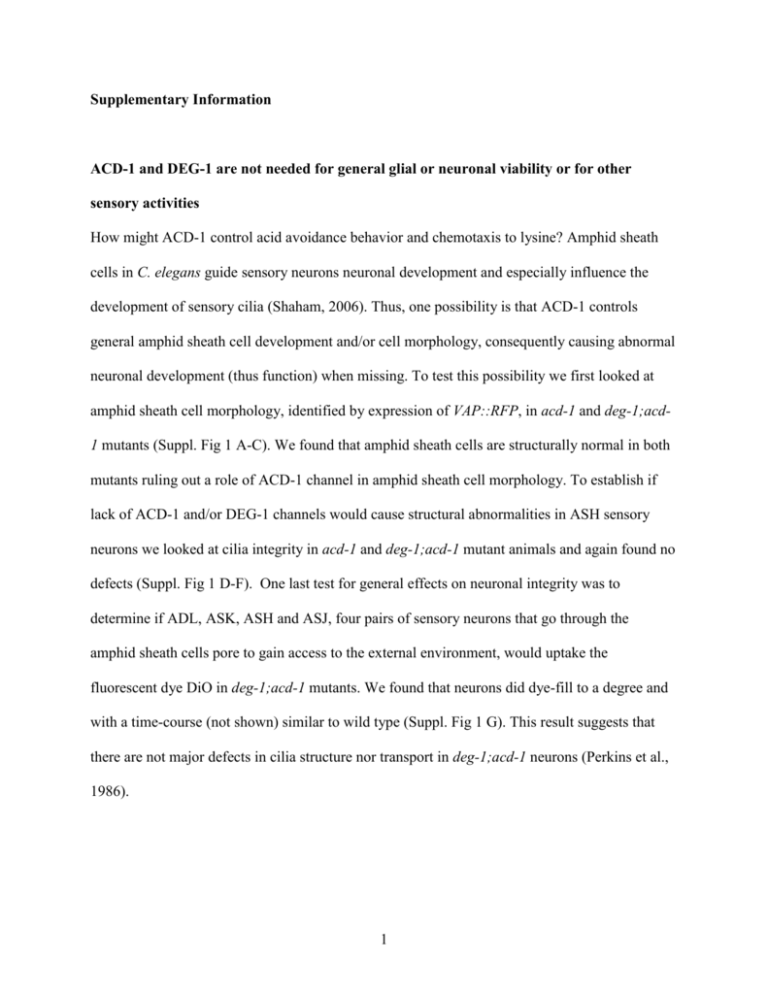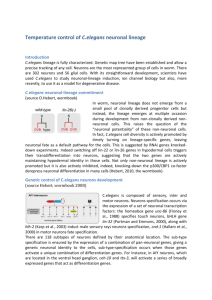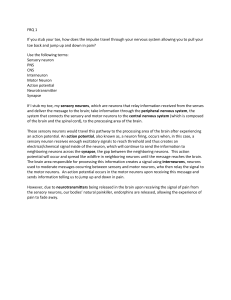Supplementary text
advertisement

Supplementary Information ACD-1 and DEG-1 are not needed for general glial or neuronal viability or for other sensory activities How might ACD-1 control acid avoidance behavior and chemotaxis to lysine? Amphid sheath cells in C. elegans guide sensory neurons neuronal development and especially influence the development of sensory cilia (Shaham, 2006). Thus, one possibility is that ACD-1 controls general amphid sheath cell development and/or cell morphology, consequently causing abnormal neuronal development (thus function) when missing. To test this possibility we first looked at amphid sheath cell morphology, identified by expression of VAP::RFP, in acd-1 and deg-1;acd1 mutants (Suppl. Fig 1 A-C). We found that amphid sheath cells are structurally normal in both mutants ruling out a role of ACD-1 channel in amphid sheath cell morphology. To establish if lack of ACD-1 and/or DEG-1 channels would cause structural abnormalities in ASH sensory neurons we looked at cilia integrity in acd-1 and deg-1;acd-1 mutant animals and again found no defects (Suppl. Fig 1 D-F). One last test for general effects on neuronal integrity was to determine if ADL, ASK, ASH and ASJ, four pairs of sensory neurons that go through the amphid sheath cells pore to gain access to the external environment, would uptake the fluorescent dye DiO in deg-1;acd-1 mutants. We found that neurons did dye-fill to a degree and with a time-course (not shown) similar to wild type (Suppl. Fig 1 G). This result suggests that there are not major defects in cilia structure nor transport in deg-1;acd-1 neurons (Perkins et al., 1986). 1 Taken together these data indicate that lack of ACD-1 channels alone or combined with deg-1 null does not cause gross abnormalities in sheath cells or sensory neurons that could explain the strong acid and lysine insensitivity of deg-1;acd-1 mutant animals. We next wondered if DEG-1 and ACD-1 channels may be specifically required for acid avoidance and chemotaxis to lysine or if they played a general role in sensory perception in C. elegans. To address this question, we looked at deg-1, acd-1 and deg-1;acd-1 mutants response to a variety of noxious stimuli (SDS, nose-touch, glycerol, copper, quinine and octanol, Suppl. Fig 1 H) and attractants (biotin, Na+, isoamylalchol, and cAMP, Suppl. Fig 1 I), and to temperature (not shown). We found that deg-1, acd-1 and deg-1;acd-1 mutant worms respond normally to all the stimuli tested (Suppl. Fig 1 H and I). Taken together our data show that DEG1 and ACD-1 channels are specifically required for acid avoidance behavior and chemotaxis to lysine and are not needed for general sensory activity. Supplementary Fig. 1: DEG-1 and ACD-1 are not needed for glia nor sensory neurons viability and are not needed for other chemosensory function (A), (B) and (C) The amphid sheath cell are normal in acd-1 and deg-1;acd-1 mutant animals. (A) Fluorescent micrograph of a VAP-1::RFP transgenic animal showing RFP signal at the amphid sheath cell process ending. (B) and (C) same as in (A) for a acd-1;VAP-1::RFP and deg-1;acd-1; VAP-1::RFP animal. (D), (E) and (F) ASH neurons cilia are normal in acd-1 and deg-1;acd-1 mutant animals. Fluorescent micrographs of ASH cilia highlighted by expression of cameleon fluorescent protein YC2.12 under the control of sra-6 promoter (Troemel et al., 1995), in WT, acd-1and deg-1;acd-1 mutant animals. Mutant strains acd-1(bz90);VAP-1:RFP, deg-1(u38u421);acd-1(bz90);VAP-1:RFP, acd-1(bz90);Psra-6::YC2.12 and deg-1(u38u421);acd-1(bz90); Psra-6::YC2.12 were obtained 2 by standard crossing. Mutations were followed and confirmed by PCR. (G) ADL, ASH, ASK and ASJ neurons of acd-1 and deg-1;acd-1 mutant animals uptake the fluorescent dye DiO (see Methods for protocol). We scored the ratio, as compared to wild type, of the average fluorescence intensity of DiO accumulated in ADL, ASH, ASK and ASJ neurons of deg-1;acd-1 mutant animals. Animals were incubated in DiO for 3 hours; similar results were obtained when incubations were 30 minutes and 1 hour long, suggesting no difference in the time-course of dye uptake. We used AdobePhotoshop to quantitate fluorescence associated with DiO accumulation by isolating pixels corresponding to ADL, ASH, ASK and ASJ neurons and determining mean luminosity. Wild type and deg-1;acd-1 mutant animals were picked to a plate containing 1,1'dioctodecyl-3,3,3',3'-tetramethylindodicarbocyanine, 4-chlorobenzinesulfonate (DiO, Molecular Probes) diluted in M9 buffer (in mM: 85 NaCl, 42.3 Na2HPO4, 22.2 KH2PO4) (0.01 mg/ml) and allowed to stain for 0.5, 1 or 3 hours at room temperature. Worms were then transferred to an agar plate and allowed to crawl on the bacterial lawn for about 15 min to destain. Photographs were taken with a Leica microscope equipped with digital camera. All photographs were taken under the same conditions and using the same exposure time (20 ms). Data are expressed as mean ± SE, n is 15 each. (H) and (I) DEG-1 and ACD-1 are not required for other sensory functions. (H) deg-1;acd-1 mutant C. elegans respond to 8 M glycerol (high osmotic avoidance). Ten to 15 animals were placed on an unseeded plate within a 1 cm ring of 8 M glycerol. After 8 minutes we counted animals that escaped the ring and animals that remained in within the ring. Avoidance index was calculated as fraction that avoid (number of animals retained by the glycerol ring divided the total number of animals assayed). A fraction of 1.0 represents complete osmotic avoidance; a fraction of 0 indicates that all animals escaped the ring. Number of trials was 3. ASH sensory neurons mediate high osmotic strength avoidance (Hart et al., 1995; Kaplan, 3 1993). deg-1;acd-1 mutant C. elegans responds to copper. We delivered 5 drops of 5 mM copper dissolved in M13 buffer to the tail of forward moving C. elegans and we scored if animals responded by backing up. Avoidance index was the ratio of responses over total number of trials. N = 12 each. Copper is sensed by ASH and to a lesser extent by ADL sensory neurons (Hilliard et al., 2005; Hilliard et al., 2004; Sambongi et al., 1999). deg-1, acd-1 and deg;acd-1 mutants respond to quinine. We delivered 5 drops of M13 solution containing 10 mM quinine to the tail of forward moving animals and calculated avoidance index as described above. N was 10 each. ASH and to a lesser extent ASK sensory neurons participate in mediating avoidance of bitter compounds including quinine (Hilliard et al., 2005; Hilliard et al., 2004). deg-1, acd-1 and deg-1;acd-1 mutant C. elegans respond to octanol. The blunt end of an eyelash hair, taped to a toothpick, was dipped in octanol and placed in front of a forward-moving animal's nose. We then determined the time it took for the animal to initiate backward movement using an audible timer. N was 20 each. ASH, ADL and AWB sensory neurons mediate octanol avoidance (Hart et al., 1999; Troemel et al., 1997). deg-1;acd-1 mutant C. elegans responds to touch to the nose. To test the nose touch response we placed an eyelash hair on an animal path while the animal was moving forward; we then recorded if the animal backed up once it became in contact with the hair (Kaplan, 1993).Animals were scored 10 times each for response to nose touch (collision test). Avoidance was quantitated as the percentage of trials in which animals responded to touch with an eyelash by stopping forward movement or reversing. N = 40 and 60. This function is mainly carried out by ASH neurons (Kaplan, 1993). deg-1, acd-1 and deg-1;acd-1 mutants respond to Sodium Dodecyl Sulfate (SDS). SDS (0.1% in M13 buffer) was assayed using the same drop test assay described above. N was 10 to 20 each. ASH sensory neurons participate in mediating avoidance of detergents including SDS (Hilliard et al., 2005; Hilliard et al., 2004). (I) 4 deg-1, acd-1 and deg-1;acd-1 mutants are attracted to biotin. Animals were tested for chemotaxis to biotin on plates in which a gradient of biotin was established by insertion of a 1 cm chunk of agar into the plate after it was incubated in 0.2 M biotin-NH4 for 3 hours. Chemotaxis index was (C.I.) (number of animals at odorant — number of animals at control)/(total number of animals). A C.I. of 1.0 indicates complete attraction; a C.I. of 0 indicates a random distribution of the worms on the assay plate. Thirty to 40 animals were assayed in each trial. Number of trials was 5 to 7. Attraction to biotin is mainly mediated by ASE and to a lesser extent by ASG, ASI, and ADF neurons (Bargmann and Horvitz, 1991). deg-1, acd-1 and deg-1;acd-1 mutant C. elegans respond to Na-acetate. A Na+ gradient was created on assay plates by incubating a chunk of agar in 0.4 M Na-acetate. Chemotaxis index was calculated as described above. Number of trials was 5 to 8 per genotype with at least 30 animals assayed in each trial. Chemotaxis to Na+ is mediated by ASE neurons and to a lesser extent by ADF, ASG and ASI sensory neurons (Bargmann and Horvitz, 1991). deg-1, acd-1 and deg-1;acd-1 mutant C. elegans are attracted to isoamyl alcohol. One microliter of isoamyl alcohol was added to one side of an assay plate and animals that were attracted to this spot were counted. Chemotaxis index was then calculated as described above. Number of trials was 2 to 3 per genotype with at least 30 animals tested in each trial. AWC chemosensory neurons mediate attraction to isoamyl alcohol (Bargmann et al., 1993; L'Etoile and Bargmann, 2000). deg-1, acd-1 and deg-1;acd-1 mutants are attracted to cAMP. Chemotaxis to cAMP was assayed using plates in which a gradient of cAMP was established as described above. The chunk of agar was incubated in 0.2 M cAMP-NH4. Number of trials was 2 to 5 per genotype with at least 30 animals assayed in each trial. ASE chemosensory neurons and to a lesser extent ADF, ASG and ASI neurons mediate attraction to cAMP (Bargmann and Horvitz, 1991). 5 Supplementary Fig. 2: The gene T02B11.3 is expressed in C. elegans amphid sheath cells. Combined DIC and fluorescent (GFP channel) micrographs of a transgenic animal expressing GFP under the control of the promoter region of T02B11.3 (~ 2 kb upstream the start codon). Note that GFP expression is evident in glial amphid sheath cells (compare with Figure 3 B and C), but cannot be detected in any neuron. Front to the left. We used the promoter of T02B11.3, which encodes for an uncharacterized small secreted protein, to drive expression of ACD-1 in glial amphid sheath cells. Our data show that exogenous expression of ACD-1 channels in glial amphid sheath cells of deg-1;acd-1 double mutants under the control of two independent promoters (vap-1 and T02B11.3) rescues acid avoidance and lysine chemotaxis sensory defects (Fig. 3 K). These results support that ACD-1 channel acts in glia and not neurons to influence C. elegans behavior. Supplementary Fig. 3: Amino acid sequence alignment of C. elegans ACD-1 and chicken ASIC1a. The amino acid postulated to be in the extracellular proton binding pocket and that changes ASIC1a proton-sensitivity when mutated to N is indicated by the arrow and red box (Jasti et al., 2007). This amino acid (D346) corresponds to D419 in C. elegans ACD-1 (numbering shifted due to gaps included in the numbering). Identical residues have blue background. Bargmann, C.I., Hartwieg, E. and Horvitz, H.R. (1993) Odorant-selective genes and neurons mediate olfaction in C. elegans. Cell, 74, 515-527. Bargmann, C.I. and Horvitz, H.R. (1991) Chemosensory neurons with overlapping functions direct chemotaxis to multiple chemicals in C. elegans. Neuron, 7, 729-742. Hart, A.C., Kass, J., Shapiro, J.E. and Kaplan, J.M. (1999) Distinct signaling pathways mediate touch and osmosensory responses in a polymodal sensory neuron. J Neurosci, 19, 19521958. 6 Hart, A.C., Sims, S. and Kaplan, J.M. (1995) Synaptic code for sensory modalities revealed by C. elegans GLR-1 glutamate receptor. Nature, 378, 82-85. Hilliard, M.A., Apicella, A.J., Kerr, R., Suzuki, H., Bazzicalupo, P. and Schafer, W.R. (2005) In vivo imaging of C. elegans ASH neurons: cellular response and adaptation to chemical repellents. Embo J, 24, 63-72. Hilliard, M.A., Bergamasco, C., Arbucci, S., Plasterk, R.H. and Bazzicalupo, P. (2004) Worms taste bitter: ASH neurons, QUI-1, GPA-3 and ODR-3 mediate quinine avoidance in Caenorhabditis elegans. Embo J, 23, 1101-1111. Jasti, J., Furukawa, H., Gonzales, E.B. and Gouaux, E. (2007) Structure of acid-sensing ion channel 1 at 1.9 A resolution and low pH. Nature, 449, 316-323. Kaplan, J.M.a.H., H. R. (1993) A dual mechanosensory and chemosensory neuron in Caenorhabditis elegans. Proc. Natl. Acad. Sci. USA., 90, 2227-2231. L'Etoile, N.D. and Bargmann, C.I. (2000) Olfaction and odor discrimination are mediated by the C. elegans guanylyl cyclase ODR-1. Neuron, 25, 575-586. Perkins, L.A., Hedgecock, E.M., Thomson, J.N. and Culotti, J.G. (1986) Mutant sensory cilia in the nematode Caenorhabditis elegans. Dev Biol, 117, 456-487. Sambongi, Y., Nagae, T., Liu, Y., Yoshimizu, T., Takeda, K., Wada, Y. and Futai, M. (1999) Sensing of cadmium and copper ions by externally exposed ADL, ASE, and ASH neurons elicits avoidance response in Caenorhabditis elegans. Neuroreport, 10, 753-757. Shaham, S. (2006) Glia-neuron interactions in the nervous system of Caenorhabditis elegans. Curr Opin Neurobiol, 16, 522-528. Troemel, E.R., Chou, J.H., Dwyer, N.D., Colbert, H.A. and Bargmann, C.I. (1995) Divergent seven transmembrane receptors are candidate chemosensory receptors in C. elegans. Cell, 83, 207-218. Troemel, E.R., Kimmel, B.E. and Bargmann, C.I. (1997) Reprogramming chemotaxis responses: sensory neurons define olfactory preferences in C. elegans. Cell, 91, 161-169. 7








